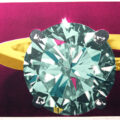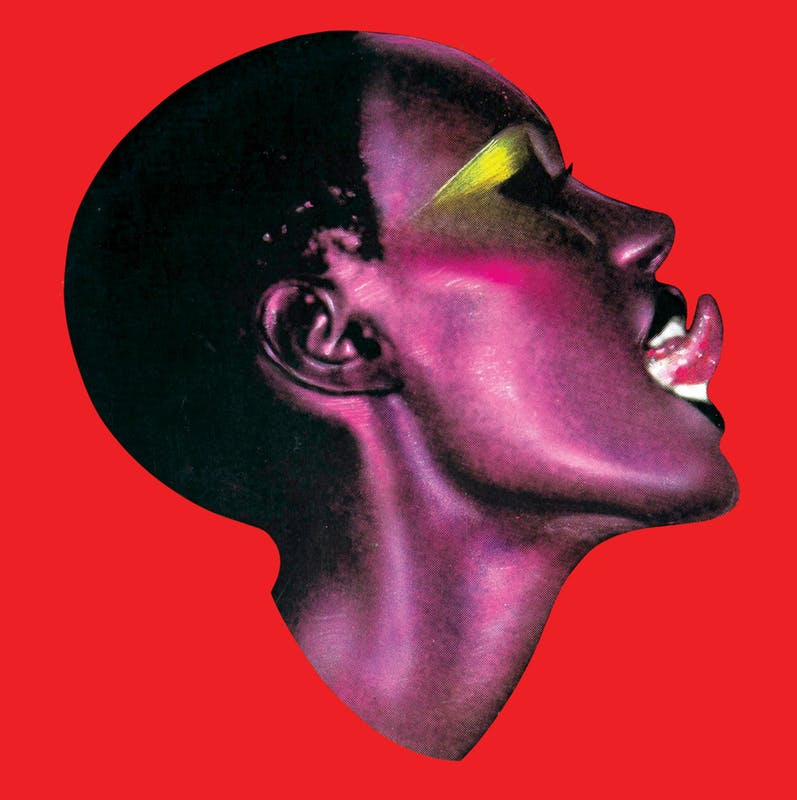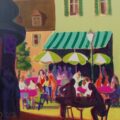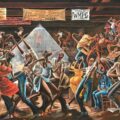Sometimes confused with Andy Warhol’s own work, Mr. Bernstein’s portraits of stars like Cher, Ali MacGraw, Tom Cruise and Sylvester Stallone captured the glittering excess of the disco era. Embellishing photographs with pencils, airbrush and pastels, he gave his subjects an idealized glow that was intensified by the large format of the magazine.
‘Richard Bernstein portrays stars,’ wrote Paloma Picasso in her introduction to ‘Megastar,’ a 1984 collection of Interview covers. ‘He celebrates their faces, he gives them larger-than-fiction size. He puts wit into the beauties, fantasy into the rich, depth into the glamorous and adds instant patina to newcomers.’
People magazine offered more matter-of-fact praise, noting that in Mr. Bernstein’s portrait of her, ‘Lily Tomlin on the telephone is as pretty as a model, and yet she still looks like Lily Tomlin.’
Mr. Bernstein was a longtime member of the Warhol circle. In the early 1960’s, he moved into the Chelsea Hotel, which became the home of Edie Sedgwick and other Warhol superstars.
In the 70’s, he mingled with the Warhol group and the fashionable crowd at clubs like Studio 54.
Mr. Bernstein created more than 120 portraits for Interview; they appeared for 15 years, starting in 1972.
He also did covers for Time magazine and for albums by the singer Grace Jones; stamp designs for the United Nations; and a portrait of Robert F. Kennedy for the Kennedy Library.
Biography:
EducationBernstein studied at Pratt Institute and Columbia University.
RÉSUMÉ:
Public CollectionsCorcoran Gallery of Fine Arts, Washington, DC; Columbus University, Dept. of Fine Arts,NY; Pratt Institute, Permanent Collection;Joseph H. Hirshorn Collection, Conn.;The Kennedy Foundation;Drew University;Stejdlik Museum, Amsterdam;Museum of Modern Art,Graphics; Metropolitan Museum of Art, Print Department, and many other public and private collections
On Oct. 18, Bernstein’s body was found on the other side of that door, in his high-ceilinged studio apartment that once was part of the Chelsea’s grand ballroom. Bernstein, whose 63rd birthday would have fallen on Halloween, had been suffering from AIDS and an ailing heart and, according to friends, a note found in his apartment that said simply “Do not resuscitate” left some with the suspicion that he had taken his own life.
Eleven days later, after Bernstein’s body had been claimed by his family and buried at Mount Ararat Cemetery in Farmingdale, Long Island, those who had worked and played with the Bronx-born, Long Island-raised artist were still learning of his death, and his passing had yet to be noted by the paper of record, The New York Times . The quiet of Bernstein’s death was ironic in light of the fact that his artwork had amplified the celebrity of so many. For 15 years, beginning in 1972, Bernstein’s signature artwork graced the monthly covers of Interview magazine, that seminal celebrity chronicle of the social, fashion and art crowd that had met in Andy Warhol’s Factory and the back room of Max’s Kansas City in the 60’s and catalyzed in the sybaritic heat of Studio 54 in the late 70’s.
Using an airbrush, pencil and pastel on photographic portraits, Bernstein made the up-and-coming celebrities of the era-Sylvester Stallone, Calvin Klein, Madonna, even wholesome Mary Tyler Moore-look as sleek and sexy as our nostalgized memories of that era. “Things are stronger, faster and further,” Paloma Picasso wrote of Bernstein’s oeuvre in a published collection of his work, Megastar . “Superstars became Megastars.”
But though Bernstein’s work helped put many a celebrity into the hot zone, he never seemed to be able to make the same conversion in terms of his own career. “I never felt that Richard got the full recognition for his contribution to the art world,” said Steve Newman, director of still photography at 20th Century Fox studios. “He never got the representation or put himself out there enough to earn the kind of reputation that other contemporaries of his did. I still think it’s a great shame.” “He was an astonishing person who lived up to about 25 percent of his potential,” said his friend, the artist Toby Rabiner.
Indeed, Mr. Newman and other friends and acquaintances of the artist said that, though he continued to create his hyper-realistic portraits on commission-designer Tom Ford was a recent subject-Bernstein’s art had moved in more abstract directions. “The last thing he wanted to do were portraits,” said the photographer and lighting designer Arthur Weinstein, a friend of several decades who lives in the Chelsea Hotel. “He was pretty actively painting up until about six months before he died.” Some who knew Bernstein said he never broke out because his work, which was clearly influenced by Warhol’s art, was too often confused with the Pope of Pop’s work, and that Warhol, who enjoyed autographing the covers of fans’ copies of Interview , didn’t work too hard to disabuse them of that notion.
Other friends said that Bernstein was too nice and not ambitious enough, and that he was often taken advantage of by those who were in a position to help him. And still others, such as Mr. Newman, said that, though Bernstein “would have liked a little more recognition,” he essentially “was happy.”
“Material things didn’t mean that much to him,” said Mr. Newman, who remembered that Bernstein’s father once had offered to help him buy a condominium in the city, but that, after considering it briefly, the artist decided he’d rather live in his artwork-crammed studio at the Chelsea.
“He was very appreciative of small pleasures,” said Ms. Rabiner, who noted that, in recent years, both she and Bernstein had lived on a shoestring. About a week before he died, Ms. Rabiner said that she treated Bernstein on a walk in a small park near the Chelsea Hotel. During their excursion, he turned to her and uttered a phrase that the two friends often used with each other when one had done something thoughtful for the other: “Another happy-with-so-little story.” But in the heady days of the 60’s and 70’s, Bernstein saw much higher highs. “I can’t think of anybody who had more fun than him, including Studio 54 co-owner Steve Rubell,” Mr. Weinstein said. “He never had any money, but he had great friends.” “He lived this amazing bohemian lifestyle,” Mr. Newman said. “He knew everybody. He was one of the great social magnates of Studio 54. He had so much knowledge-firsthand knowledge,” as well as “an amazing ability to walk up to anybody and engage them in a conversation.”
“There was an elegance about him,” said the publicist Jules Feiler, who had done some recent work for Bernstein, including getting his art displayed on the fifth floor of the Gershwin Hotel. “When you went in to have an ice coffee and a cigarette with Richard Bernstein, it was like visiting royalty.”
The son of a haberdasher, Bernstein got his bachelor’s degree in fine arts from the Pratt Institute and did some graduate work at Columbia. After showing some early work at the New York’s Terrain gallery in 1965 and getting some critical, he fell in with the crowd in the back room at Max’s Kansas City. He called the room the “Bucket of Blood” and would eventually immortalize it in a red-hued print that became a coveted gift for friends and associates.
Writer Glenn O’Brien was the editor of Interview when Bernstein was hired in 1972, and he remembered his former colleague as “an old-world bohemian type that you don’t see much of in New York anymore. Nobody was allowed to smoke pot at the Factory, but Richard was the only person before Jean-Michel Basquiat who could get away with it. He would light up with impunity. If anyone had any attitude, he would tut-tut them and correct their attitude.” Mr. O’Brien added: “Fred was fun, but Richard was loose.” With his dark, wavy hair, good looks and unfussy fashion sense-black jeans, leather jackets-Bernstein attracted members of both sexes, and though he was gay, he had at least one significant relationship with a woman, the actress and photographer Berry Berenson.
Bernstein was dating-and at one point, according to Ms. Rabiner and other friends engaged to-Ms. Berenson when he began working at Interview . And, many of those friends said, he encouraged Ms. Berenson to interview the actor Anthony Perkins, upon whom she had developed a crush, for the magazine. “He lived to regret that,” said Ms. Rabiner. Ms. Berenson fell for Mr. Perkins and Bernstein was crushed. “He suffered a nervous breakdown at that point,” said Mr. Newman.
Still, Bernstein maintained a close friendship with Ms. Berenson and was devastated a second time when she died in the terrorist attacks of Sept. 11, 2001. Eventually, Bernstein was able to lose himself in the drug-and-alcohol-fueled scene that sprung up around Studio 54. His friends ran the gamut from French actor Alain Delon to disco proprietress Regine to Virgil Thompson to the angular actress and singer Grace Jones.
In a phone call from London, Ms. Jones recalled that Bernstein was “more like family than a friend. He was a godfather and art father to my son, Paulo. We called him Uncle Richard.”
“He was an extremely loyal friend,” Ms. Jones added. When times were flush, Ms. Jones said she often threw lavish parties with “bathtubs full of Cristal champagne” and her mother’s Jamaican cooking, but she recounted how once, during a later, leaner time in her life, she asked friends to bring their own liquor to one of her soirees. “I remember only about five people showed up,” she said. Bernstein was one of them. “So you can see he was very special in my life,” she said.
Indeed, Ms. Jones said that she and Bernstein served as mutual muses for each other. He did the artwork for her first single, “I Need A Man,” and then for every one of her albums up to 1980’s Warm Leatherette . Bernstein also worked with artist Antonia López on Ms. Jones’ 1986 vampire movie, Vamp . And she said it was Bernstein’s idea to dress her as a luminescent chandelier for her dramatic performance of “La Vie en Rose” at a tribute to the artist Erté at the Metropolitan Museum of Art.
And Fox’s Mr. Newman said that he met Bernstein in 1985 when the studio executive was working with Ms. Jones on the James Bond film, A View to a Kill . Mr. Newman said it was Bernstein’s suggestion to hire the photographer George Hurrell and photograph Ms. Jones in the glamorous 40’s style for which Hurrell had become famous. “The pictures of Grace ran in magazines all over the world,” Mr. Newman said. “Richard to me was the connection between the old glamour of Hollywood world and the art world, but he added his own contemporary sensibility to it, which was like his art work,” Mr. Newman said.
And, like a number of friends, Mr. Newman is worried about what is going to happen to that art work. Friends said Bernstein had written out a will, but failed to sign it before he died. Since his death, his apartment has been sealed by the police department pending settlement of his estate, according to management at the Chelsea.
Bernstein is survived by a sister Ellen Trifon, and a brother, David Bernstein, as well as a number of nieces and nephews. (Though friends said Bernstein was estranged from his family for many years because of his lifestyle, chances are, the fate of his estate-Mr. Newman estimated that his friend left behind “thousands” of artworks, including his Interview output, though Mr. Weinstein said the number was much smaller-and his legacy as an artist will be determined by their actions. “It’s in the family’s hands,” Mr. Newman said. “I just hope that the family understands the value of it.”
Meanwhile, Ms. Jones said she was planning to start an AIDS foundation in Bernstein’s name. “His birthday would have been on the 31st. We were supposed to meet then,” she said. “I’m going to miss him but we have to celebrate his life before. He would like that.”
-Frank DiGiacomo” target=”_blank”>download “Quiet please,” reads a black sticker on the tall red door to the ground-floor apartment that artist Richard Bernstein kept at the Chelsea Hotel. And for almost two weeks, this city seemed all too willing to oblige.
On Oct. 18, Bernstein’s body was found on the other side of that door, in his high-ceilinged studio apartment that once was part of the Chelsea’s grand ballroom. Bernstein, whose 63rd birthday would have fallen on Halloween, had been suffering from AIDS and an ailing heart and, according to friends, a note found in his apartment that said simply “Do not resuscitate” left some with the suspicion that he had taken his own life.
Eleven days later, after Bernstein’s body had been claimed by his family and buried at Mount Ararat Cemetery in Farmingdale, Long Island, those who had worked and played with the Bronx-born, Long Island-raised artist were still learning of his death, and his passing had yet to be noted by the paper of record, The New York Times . The quiet of Bernstein’s death was ironic in light of the fact that his artwork had amplified the celebrity of so many. For 15 years, beginning in 1972, Bernstein’s signature artwork graced the monthly covers of Interview magazine, that seminal celebrity chronicle of the social, fashion and art crowd that had met in Andy Warhol’s Factory and the back room of Max’s Kansas City in the 60’s and catalyzed in the sybaritic heat of Studio 54 in the late 70’s.
Using an airbrush, pencil and pastel on photographic portraits, Bernstein made the up-and-coming celebrities of the era-Sylvester Stallone, Calvin Klein, Madonna, even wholesome Mary Tyler Moore-look as sleek and sexy as our nostalgized memories of that era. “Things are stronger, faster and further,” Paloma Picasso wrote of Bernstein’s oeuvre in a published collection of his work, Megastar . “Superstars became Megastars.”
But though Bernstein’s work helped put many a celebrity into the hot zone, he never seemed to be able to make the same conversion in terms of his own career. “I never felt that Richard got the full recognition for his contribution to the art world,” said Steve Newman, director of still photography at 20th Century Fox studios. “He never got the representation or put himself out there enough to earn the kind of reputation that other contemporaries of his did. I still think it’s a great shame.” “He was an astonishing person who lived up to about 25 percent of his potential,” said his friend, the artist Toby Rabiner.
Indeed, Mr. Newman and other friends and acquaintances of the artist said that, though he continued to create his hyper-realistic portraits on commission-designer Tom Ford was a recent subject-Bernstein’s art had moved in more abstract directions. “The last thing he wanted to do were portraits,” said the photographer and lighting designer Arthur Weinstein, a friend of several decades who lives in the Chelsea Hotel. “He was pretty actively painting up until about six months before he died.” Some who knew Bernstein said he never broke out because his work, which was clearly influenced by Warhol’s art, was too often confused with the Pope of Pop’s work, and that Warhol, who enjoyed autographing the covers of fans’ copies of Interview , didn’t work too hard to disabuse them of that notion.
Other friends said that Bernstein was too nice and not ambitious enough, and that he was often taken advantage of by those who were in a position to help him. And still others, such as Mr. Newman, said that, though Bernstein “would have liked a little more recognition,” he essentially “was happy.”
“Material things didn’t mean that much to him,” said Mr. Newman, who remembered that Bernstein’s father once had offered to help him buy a condominium in the city, but that, after considering it briefly, the artist decided he’d rather live in his artwork-crammed studio at the Chelsea.
“He was very appreciative of small pleasures,” said Ms. Rabiner, who noted that, in recent years, both she and Bernstein had lived on a shoestring. About a week before he died, Ms. Rabiner said that she treated Bernstein on a walk in a small park near the Chelsea Hotel. During their excursion, he turned to her and uttered a phrase that the two friends often used with each other when one had done something thoughtful for the other: “Another happy-with-so-little story.” But in the heady days of the 60’s and 70’s, Bernstein saw much higher highs. “I can’t think of anybody who had more fun than him, including [Studio 54 co-owner] Steve Rubell,” Mr. Weinstein said. “He never had any money, but he had great friends.” “He lived this amazing bohemian lifestyle,” Mr. Newman said. “He knew everybody. He was one of the great social magnates of Studio 54. He had so much knowledge-firsthand knowledge,” as well as “an amazing ability to walk up to anybody and engage them in a conversation.”
“There was an elegance about him,” said the publicist Jules Feiler, who had done some recent work for Bernstein, including getting his art displayed on the fifth floor of the Gershwin Hotel. “When you went in to have an ice coffee and a cigarette with Richard Bernstein, it was like visiting royalty.”
The son of a haberdasher, Bernstein got his bachelor’s degree in fine arts from the Pratt Institute and did some graduate work at Columbia. After showing some early work at the New York’s Terrain gallery in 1965 and getting some critical, he fell in with the crowd in the back room at Max’s Kansas City. He called the room the “Bucket of Blood” and would eventually immortalize it in a red-hued print that became a coveted gift for friends and associates.
Writer Glenn O’Brien was the editor of Interview when Bernstein was hired in 1972, and he remembered his former colleague as “an old-world bohemian type that you don’t see much of in New York anymore. Nobody was allowed to smoke pot at the Factory, but Richard was the only person before Jean-Michel Basquiat who could get away with it. He would light up with impunity. If anyone had any attitude, he would tut-tut them and correct their attitude.” Mr. O’Brien added: “Fred was fun, but Richard was loose.” With his dark, wavy hair, good looks and unfussy fashion sense-black jeans, leather jackets-Bernstein attracted members of both sexes, and though he was gay, he had at least one significant relationship with a woman, the actress and photographer Berry Berenson.
Bernstein was dating-and at one point, according to Ms. Rabiner and other friends engaged to-Ms. Berenson when he began working at Interview . And, many of those friends said, he encouraged Ms. Berenson to interview the actor Anthony Perkins, upon whom she had developed a crush, for the magazine. “He lived to regret that,” said Ms. Rabiner. Ms. Berenson fell for Mr. Perkins and Bernstein was crushed. “He suffered a nervous breakdown at that point,” said Mr. Newman.
Still, Bernstein maintained a close friendship with Ms. Berenson and was devastated a second time when she died in the terrorist attacks of Sept. 11, 2001. Eventually, Bernstein was able to lose himself in the drug-and-alcohol-fueled scene that sprung up around Studio 54. His friends ran the gamut from French actor Alain Delon to disco proprietress Regine to Virgil Thompson to the angular actress and singer Grace Jones.
In a phone call from London, Ms. Jones recalled that Bernstein was “more like family than a friend. He was a godfather and art father to my son, Paulo. We called him Uncle Richard.”
“He was an extremely loyal friend,” Ms. Jones added. When times were flush, Ms. Jones said she often threw lavish parties with “bathtubs full of Cristal champagne” and her mother’s Jamaican cooking, but she recounted how once, during a later, leaner time in her life, she asked friends to bring their own liquor to one of her soirees. “I remember only about five people showed up,” she said. Bernstein was one of them. “So you can see he was very special in my life,” she said.
Indeed, Ms. Jones said that she and Bernstein served as mutual muses for each other. He did the artwork for her first single, “I Need A Man,” and then for every one of her albums up to 1980’s Warm Leatherette . Bernstein also worked with artist Antonia López on Ms. Jones’ 1986 vampire movie, Vamp . And she said it was Bernstein’s idea to dress her as a luminescent chandelier for her dramatic performance of “La Vie en Rose” at a tribute to the artist Erté at the Metropolitan Museum of Art.
And Fox’s Mr. Newman said that he met Bernstein in 1985 when the studio executive was working with Ms. Jones on the James Bond film, A View to a Kill . Mr. Newman said it was Bernstein’s suggestion to hire the photographer George Hurrell and photograph Ms. Jones in the glamorous 40’s style for which Hurrell had become famous. “The pictures of Grace ran in magazines all over the world,” Mr. Newman said. “Richard to me was the connection between the old glamour of Hollywood world and the art world, but he added his own contemporary sensibility to it, which was like his art work,” Mr. Newman said.
And, like a number of friends, Mr. Newman is worried about what is going to happen to that art work. Friends said Bernstein had written out a will, but failed to sign it before he died. Since his death, his apartment has been sealed by the police department pending settlement of his estate, according to management at the Chelsea.
Bernstein is survived by a sister Ellen Trifon, and a brother, David Bernstein, as well as a number of nieces and nephews. (Though friends said Bernstein was estranged from his family for many years because of his lifestyle, chances are, the fate of his estate-Mr. Newman estimated that his friend left behind “thousands” of artworks, including his Interview output, though Mr. Weinstein said the number was much smaller-and his legacy as an artist will be determined by their actions. “It’s in the family’s hands,” Mr. Newman said. “I just hope that the family understands the value of it.”
Meanwhile, Ms. Jones said she was planning to start an AIDS foundation in Bernstein’s name. “His birthday would have been on the 31st. We were supposed to meet then,” she said. “I’m going to miss him but we have to celebrate his life before. He would like that.”
-Frank DiGiacomo
Additional Information:
Born: 1942
Birthplace: New York, NY
Died: 2002
Website: http://www.jahsonic.com/RichardBernstein.html[/fusion_builder_column][/fusion_builder_row][/fusion_builder_container]




